The Intel 6th Gen Skylake Review: Core i7-6700K and i5-6600K Tested
by Ian Cutress on August 5, 2015 8:00 AM ESTGenerational Tests on the i7-6700K: Gaming Benchmarks on Mid-Range GPUs
Alien: Isolation
If first person survival mixed with horror is your sort of thing, then Alien: Isolation, based off of the Alien franchise, should be an interesting title. Developed by The Creative Assembly and released in October 2014, Alien: Isolation has won numerous awards from Game Of The Year to several top 10s/25s and Best Horror titles, ratcheting up over a million sales by February 2015. Alien: Isolation uses a custom built engine which includes dynamic sound effects and should be fully multi-core enabled.
For low end graphics, we test at 720p with Ultra settings, whereas for mid and high range graphics we bump this up to 1080p, taking the average frame rate as our marker with a scripted version of the built-in benchmark.
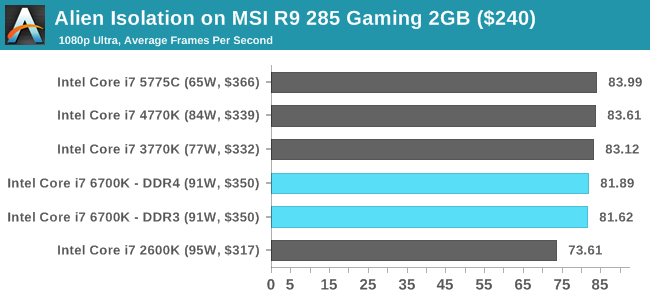
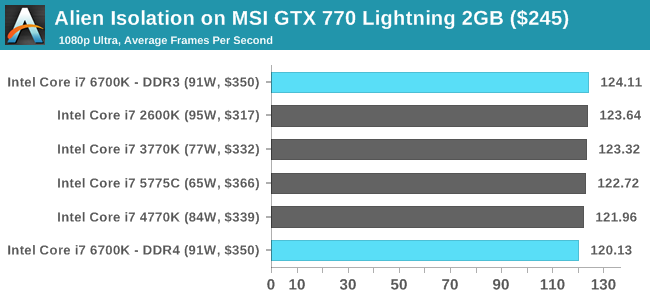
Total War: Attila
The Total War franchise moves on to Attila, another The Creative Assembly development, and is a stand-alone strategy title set in 395AD where the main story line lets the gamer take control of the leader of the Huns in order to conquer parts of the world. Graphically the game can render hundreds/thousands of units on screen at once, all with their individual actions and can put some of the big cards to task.
For low end graphics, we test at 720p with performance settings, recording the average frame rate. With mid and high range graphics, we test at 1080p with the quality setting. In both circumstances, unlimited video memory is enabled and the in-game scripted benchmark is used.
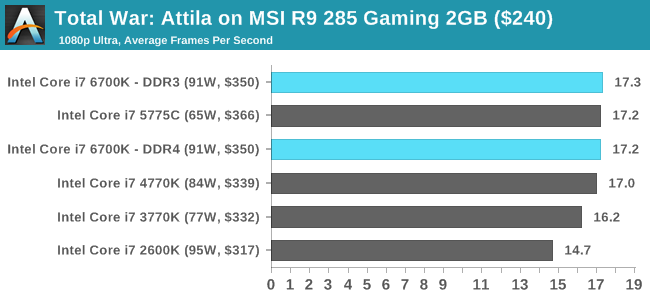
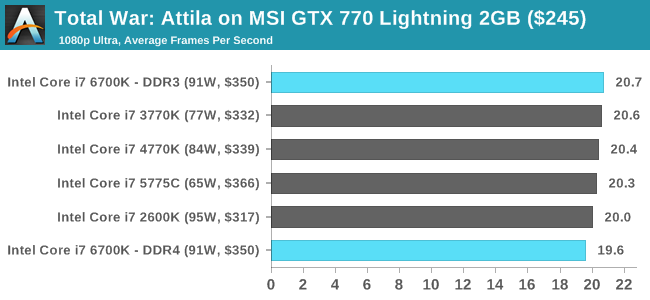
Grand Theft Auto V
The highly anticipated iteration of the Grand Theft Auto franchise finally hit the shelves on April 14th 2015, with both AMD and NVIDIA in tow to help optimize the title. GTA doesn’t provide graphical presets, but opens up the options to users and extends the boundaries by pushing even the hardest systems to the limit using Rockstar’s Advanced Game Engine. Whether the user is flying high in the mountains with long draw distances or dealing with assorted trash in the city, when cranked up to maximum it creates stunning visuals but hard work for both the CPU and the GPU.
For our test we have scripted a version of the in-game benchmark, relying only on the final part which combines a flight scene along with an in-city drive-by followed by a tanker explosion. For low end systems we test at 720p on the lowest settings, whereas mid and high end graphics play at 1080p with very high settings across the board. We record both the average frame rate and the percentage of frames under 60 FPS (16.6ms).
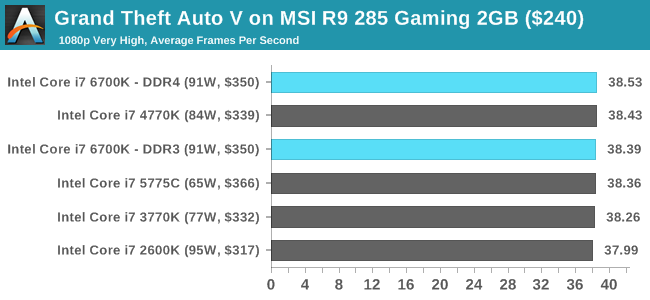
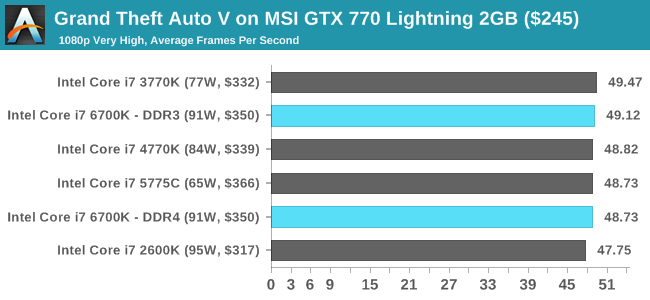
GRID: Autosport
No graphics tests are complete without some input from Codemasters and the EGO engine, which means for this round of testing we point towards GRID: Autosport, the next iteration in the GRID and racing genre. As with our previous racing testing, each update to the engine aims to add in effects, reflections, detail and realism, with Codemasters making ‘authenticity’ a main focal point for this version.
GRID’s benchmark mode is very flexible, and as a result we created a test race using a shortened version of the Red Bull Ring with twelve cars doing two laps. The car is focus starts last and is quite fast, but usually finishes second or third. For low end graphics we test at 1080p medium settings, whereas mid and high end graphics get the full 1080p maximum. Both the average and minimum frame rates are recorded.
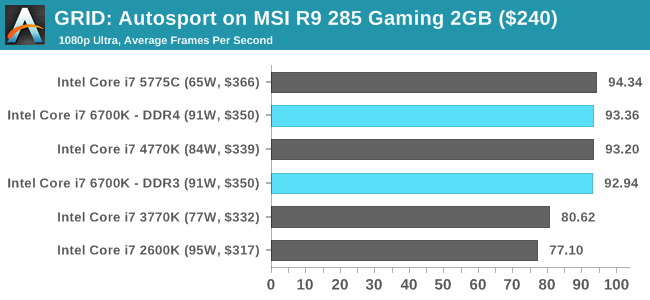
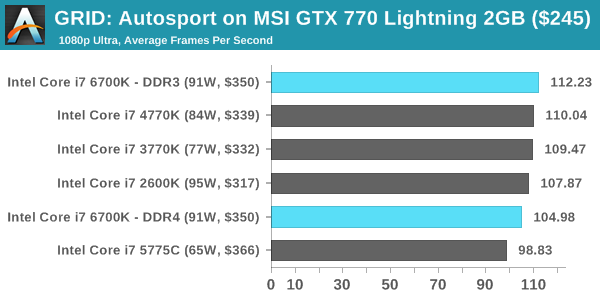
Middle-Earth: Shadow of Mordor
The final title in our testing is another battle of system performance with the open world action-adventure title, Shadow of Mordor. Produced by Monolith using the LithTech Jupiter EX engine and numerous detail add-ons, SoM goes for detail and complexity to a large extent, despite having to be cut down from the original plans. The main story itself was written by the same writer as Red Dead Redemption, and it received Zero Punctuation’s Game of The Year in 2014.
For testing purposes, SoM gives a dynamic screen resolution setting, allowing us to render at high resolutions that are then scaled down to the monitor. As a result, we get several tests using the in-game benchmark. For low end graphics we examine at 720p with low settings, whereas mid and high end graphics get 1080p Ultra. The top graphics test is also redone at 3840x2160, also with Ultra settings, and we also test two cards at 4K where possible.
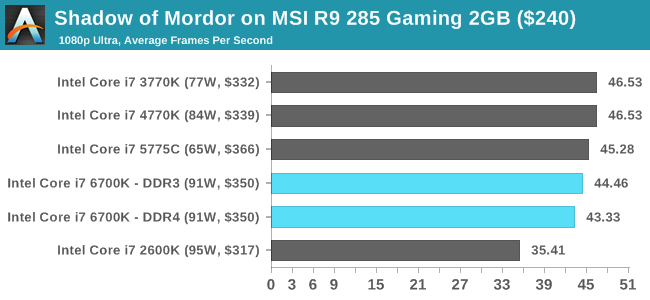
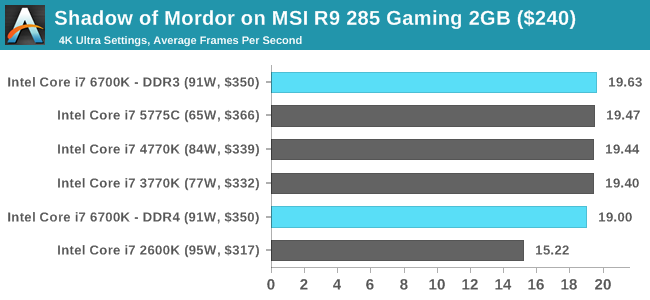

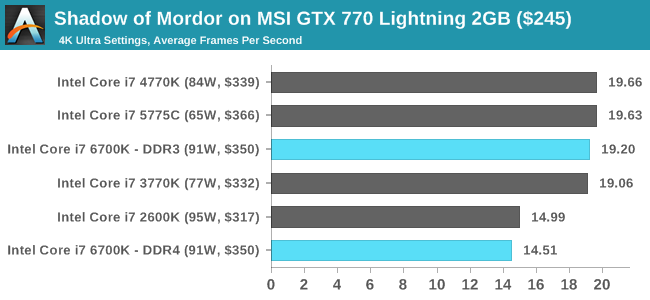















477 Comments
View All Comments
DanNeely - Wednesday, August 5, 2015 - link
Reliability might start to be a concern in the next year or two. I had a 920 and a 930 (bought right after release and about a year later); but back in June the 920 stopped POSTing. Since I did a precautionary upgrade to a 4790K at the start of the year it didn't impact me; and I haven't gotten around to doing any part swaps to figure out which component failed yet. (Not so I can buy a replacement part; but so I know what's potentially usable as a spare if/when the 930 does the same.)06GTOSC - Wednesday, August 5, 2015 - link
Looks to me that I'm not missing anything for gaming by staying with my 4790k.nmm - Wednesday, August 5, 2015 - link
Well, that was a bit underwhelming. Fantastic article, of course, but I can't agree that this is a nail in the coffin for Sandy Bridge. For myself, I think I'll just upgrade the cooler on my i7 2600k and bump the multiplier up a few notches and hold out for another year. When there are some reasonably cheap NVME options and affordable/fast high capacity DDR4 modules and Pascal GPU's, that will probably be the right time for me to break up with Sandy.piroroadkill - Wednesday, August 5, 2015 - link
Definitely not the nail in the coffin for Sandy, far from it.In games, there's still no point to upgrading..
Jon Tseng - Wednesday, August 5, 2015 - link
TBH I'm not missing anything staying with my QX6850! (65nm FTW). GPU is all that matters nowadays...postem - Wednesday, August 5, 2015 - link
That was my doubt when i was up to wait 6 months or get DC to replace old 950. The difference is mainly negligible from DC, but there will be much more costly due to new mobos, DDR4 and so on.kenansadhu - Saturday, August 8, 2015 - link
Were you really thinking about upgrading to skylake when you bought your 4790k?Refuge - Wednesday, August 5, 2015 - link
I wanna know whats going on under the hood. Can't wait for the follow up article.Otherwise I'm disappointed, if you claim this is the end for Sandybridge, then anyone who agree's and is upgrading lemme know, I'll gladly take your old hardware for cheap.
With this performance I'd be happier buying a Devilscanyon for less and wait for Intel to actually give me something worth spending $220+ on.
Skylake, I am very disappoint.
otimus - Wednesday, August 5, 2015 - link
Says "Sandy Bridge, your time is up" proceeds to practically show data as to why it is not. Especially for gaming.Do you guys just not live in reality, or does getting things for free just flat out cloud your mind to the staggering cost it'd take to go from Sandy Bridge to Skylake for what seems like a very few FPS? Even worse, I imagine most folks are still on 60 Hz monitors.
Refuge - Wednesday, August 5, 2015 - link
I have a lot of respect for you Ian, but I completely disagree that Sandy's time is up, and if it is? Skylake isn't the cause. This is such a terrible release haha. I hope it is just some launch kinks that need ironed out.Otherwise Devils Canyon is where its at. Older gen so it is cheaper, and it is more compelling than this slab of silicon. Other than increased iGPU performance with DDR4 memory, there isn't a single gain I saw in any of these benchmarks that is noticeable to an end user.